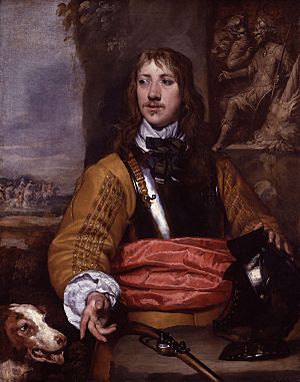Richard Neville (soldier) facts for kids
Richard Neville (born May 30, 1615 – died October 7, 1676) was an important figure during the English Civil War. He fought for the Royalist side, supporting King Charles I. He became well-known as a commander at the First Battle of Newbury in 1643.
Contents
Early Life and Family
Richard Neville was born at Billingbear House in Waltham St Lawrence, England. His father was Sir Henry Neville, who passed away in 1629. Richard went to Queens' College, Cambridge in 1631 to study. He had a younger brother named Henry Neville, who later became a writer.
Richard's mother, Elizabeth, was given rights to the family estate during her lifetime. She later married Sir John Thorowgood and lived until 1669. Richard's grandfather was Henry Neville, who was a politician and diplomat during the time of Queen Elizabeth I.
Fighting in the English Civil War
Richard Neville joined the Royalist army during the English Civil War. He served under the Earl of Carnarvon at the First Battle of Newbury in 1643. This was a very important battle. When the Earl of Carnarvon was killed, Richard Neville took over command. He became a Colonel of Horse, leading cavalry troops.
In 1643–44, he was appointed High Sheriff of Berkshire, which was an important local government role. In April 1644, he was asked to create a special army group called the Berkshire Trained Bands. This group was meant to protect the town of Reading.
However, the next month, the Royalists decided to destroy Reading's defenses and move their main army base to Oxford. Richard Neville's regiment continued to serve the King there. He was with King Charles I in Oxford in 1646.
Life After the War
After the war ended and the monarchy was brought back (this was called the Restoration), Richard Neville continued to serve his community. From 1660 until his death, he worked as a Justice of the Peace and a Deputy Lieutenant for Berkshire. These roles involved keeping law and order and helping with local defense.
In 1667, something special happened at his home, Billingbear House. The local church records in Waltham St Lawrence noted:
September 17th, 1667, King Charles 2nd, with his brother James Duke of Yorke, Prince Rupert Duke of Cumberland, James Duke of Monmouth and many more of the nobles dined at Bellingbeare in the great Parlour.
This means that King Charles II and other important people visited and had dinner at Richard Neville's house!
In 1670, Richard Neville was elected to Parliament. He became a Member of Parliament (MP) for Berkshire.
Family and Legacy
Richard Neville married Anne, who was the daughter of Sir John Heydon. Sir John Heydon was an important military officer. Richard and Anne had two sons and five daughters.
When Richard Neville passed away on October 7, 1676, he was buried in Waltham St Lawrence. He left his family estates to his older son, John. However, John died without having any children. So, the estates later went to Richard's younger son, also named Richard.


